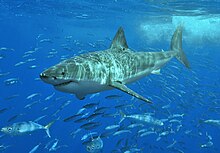
Back Lamniformes Afrikaans قروش حديثة Arabic قروش حديثه ARZ Lamnokimilər Azerbaijani Ламнообразни акули Bulgarian Lamniformes Catalan Lamniformes CEB Obrouni Czech Makrelenhaiartige German Lamnoformaj Esperanto
| Lamniformes Temporal range: Possible Late Jurassic record
| |
|---|---|

| |
| Great white shark, Carcharodon carcharias | |
| Scientific classification | |
| Domain: | Eukaryota |
| Kingdom: | Animalia |
| Phylum: | Chordata |
| Class: | Chondrichthyes |
| Subclass: | Elasmobranchii |
| Clade: | Neoselachii |
| Subdivision: | Selachimorpha |
| Superorder: | Galeomorphii |
| Order: | Lamniformes L. S. Berg, 1958 |
| Families | |
|
See text | |
The Lamniformes (/ˈlæmnɪfɔːrmiːz/, from Greek lamna "fish of prey") are an order of sharks commonly known as mackerel sharks (which may also refer specifically to the family Lamnidae). It includes some of the most familiar species of sharks, such as the great white,[1] as well as more unusual representatives, such as the goblin shark and megamouth shark.
Members of the order are distinguished by possessing two dorsal fins, an anal fin, five gill slits, eyes without nictitating membranes, and a mouth extending behind the eyes. Species in two families of Lamniformes – Lamnidae and Alopiidae – are distinguished for maintaining a higher body temperature than the surrounding waters.[2]
Members of the group include macropredators, generally of medium-large size, including the largest macropredatory shark ever, the extinct Otodus megalodon, as well as large planktivores.[3]
The small ~1 metre (3.3 ft) long carpet shark-like Palaeocarcharias, known from the Middle and Late Jurassic, shares the distinctive tooth histology of most lamniform sharks, which lack orthodentine, and is thus considered either the oldest lamniform or a sister group to all lamniforms.[4][5][6] Lamniformes underwent a major adaptive radiation during the Cretaceous and became prominent elements of oceanic ecosystems.[6][7][3][8] They reached their highest diversity during the Late Cretaceous, but severely declined during the K-Pg extinction, before rebounding to a high but lower diversity peak during the Paleogene. Lamniformes have severely declined over the last 20 million years, with only 15 species alive today, compared to over 290 extant species in the Carcharhiniformes, which have evolved into medium and large body sizes during the same timeframe. The causes of the decline are uncertain, but are likely to have involved both biotic factors like competition and non-biotic factors like temperature and sea level.[9][10]
- ^ Pimiento, Catalina; Cantalapiedra, Juan L.; Shimada, Kenshu; Field, Daniel J.; Smaers, Jeroen B. (24 January 2019). "Evolutionary pathways toward gigantism in sharks and rays". Evolution. 73 (2): 588–599. doi:10.1111/evo.13680. PMID 30675721. S2CID 59224442.
- ^ Donley, Jeanine M.; Sepulveda, Chugey A.; Aalbers, Scott A.; McGillivray, David G.; Syme, Douglas A.; Bernal, Diego (2012-04-13). "Effects of temperature on power output and contraction kinetics in the locomotor muscle of the regionally endothermic common thresher shark (Alopias vulpinus)". Fish Physiology and Biochemistry. 38 (5): 1507–1519. doi:10.1007/s10695-012-9641-1. ISSN 0920-1742. PMID 22527612. S2CID 1100494.
- ^ a b Shimada, Kenshu; Becker, Martin A.; Griffiths, Michael L. (2021-11-02). "Body, jaw, and dentition lengths of macrophagous lamniform sharks, and body size evolution in Lamniformes with special reference to 'off-the-scale' gigantism of the megatooth shark, Otodus megalodon". Historical Biology. 33 (11): 2543–2559. doi:10.1080/08912963.2020.1812598. ISSN 0891-2963. S2CID 224935604.
- ^ Jambura, Patrick L.; Kindlimann, René; López-Romero, Faviel; Marramà, Giuseppe; Pfaff, Cathrin; Stumpf, Sebastian; Türtscher, Julia; Underwood, Charlie J.; Ward, David J.; Kriwet, Jürgen (2019-07-04). "Micro-computed tomography imaging reveals the development of a unique tooth mineralization pattern in mackerel sharks (Chondrichthyes; Lamniformes) in deep time". Scientific Reports. 9 (1): 9652. Bibcode:2019NatSR...9.9652J. doi:10.1038/s41598-019-46081-3. ISSN 2045-2322. PMC 6609643. PMID 31273249.
- ^ Landemaine, Olivier; Thies, Detlev; Waschkewitz, Jens (2018-11-01). "The Late Jurassic shark Palaeocarcharias (Elasmobranchii, Selachimorpha) – functional morphology of teeth, dermal cephalic lobes and phylogenetic position". Palaeontographica Abteilung A: 103–165. doi:10.1127/0375-0442/2018/0000/0085.
- ^ a b Jambura, Patrick L.; Stumpf, Sebastian; Kriwet, Jürgen (2021-09-01). "Skeletal remains of the oldest known pseudocoracid shark Pseudocorax kindlimanni sp. nov. (Chondrichthyes, Lamniformes) from the Late Cretaceous of Lebanon". Cretaceous Research. 125: 104842. doi:10.1016/j.cretres.2021.104842. ISSN 0195-6671. PMC 7611798.
- ^ Underwood, Charlie J. (March 2006). "Diversification of the Neoselachii (Chondrichthyes) during the Jurassic and Cretaceous". Paleobiology. 32 (2): 215–235. Bibcode:2006Pbio...32..215U. doi:10.1666/04069.1. ISSN 0094-8373. S2CID 86232401.
- ^ Guinot, Guillaume; Adnet, Sylvain; Cappetta, Henri (2012-09-05). MacKenzie, Brian R. (ed.). "An Analytical Approach for Estimating Fossil Record and Diversification Events in Sharks, Skates and Rays". PLOS ONE. 7 (9): e44632. Bibcode:2012PLoSO...744632G. doi:10.1371/journal.pone.0044632. ISSN 1932-6203. PMC 3434181. PMID 22957091.
- ^ Bazzi, Mohamad; Campione, Nicolás E.; Kear, Benjamin P.; Pimiento, Catalina; Ahlberg, Per E. (2021-12-06). "Feeding ecology has shaped the evolution of modern sharks". Current Biology. 31 (23): 5138–5148.e4. doi:10.1016/j.cub.2021.09.028. ISSN 0960-9822. PMID 34614390.
- ^ Condamine, Fabien L.; Romieu, Jules; Guinot, Guillaume (2019-10-08). "Climate cooling and clade competition likely drove the decline of lamniform sharks". Proceedings of the National Academy of Sciences. 116 (41): 20584–20590. Bibcode:2019PNAS..11620584C. doi:10.1073/pnas.1902693116. ISSN 0027-8424. PMC 6789557. PMID 31548392.
© MMXXIII Rich X Search. We shall prevail. All rights reserved. Rich X Search